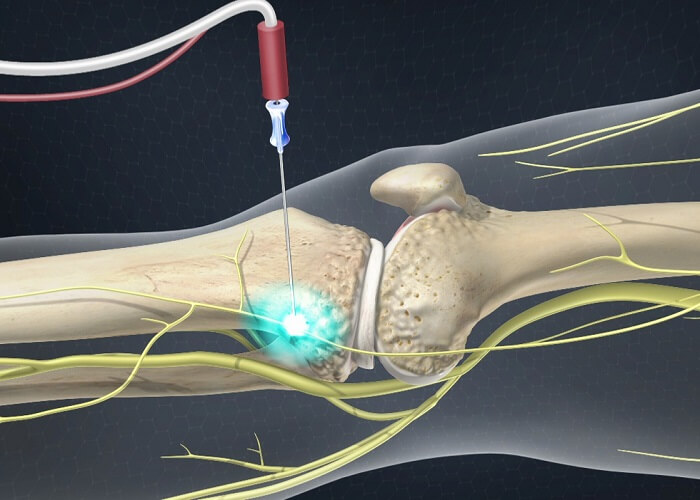ورود به فاز درمانی با رادیوفرکانس
درمان زانودرد با امواج رادیویی دو مرحله اصلی دارد:
1. مرحله تشخیصی
2. مرحله درمانی
مراحل فاز تشخیصی درمان زانودرد با امواج رادیویی
1. بیمار روی تخت به پشت دراز میکشد.
2. سپس پزشک پوست اطراف زانو را تمیز میکند که عفونت ایجاد نشود.
3. منطقهای که عصب ژنیکولار در آنجا قرار دارد با دستگاه فلوروسکوپ (با استفاده از تابش پرتو X) تعیین و روی پوست علامتگذاری میشود.
4. پزشک قبل از تزریق مواد بیحسکننده پوست و بافتهای زیر آن را بیحس میکند که بیمار دردی را احساس نکند.
5. سپس سه سوزن با کمک فلوروسکوپی در زانو قرار گرفته میشود. این 3 نقطه، محل تلاقی استخوان ران با اپیکوندیل داخلی و خارجی و تلاقی استخوان درشتنی با اپیکوندیل داخلی هستند.
6. بعد از قرارگیری سوزنها در محل خود، مواد حاجب به محل تزریق میشوند تا اطمینان حاصل شود سوزن ها در محل مناسب خود قرار داده شدهاند.
7. در مرحله آخر نیز مواد بیحسکننده موضعی در محل موردنظر تزریق میشوند.
بعد از پایان انسداد اعصاب ژنیکولار، فرد در زانوی خود احساس بیحسی و کمی سوزنسوزن شدن میکند.
بعد از مرحله تشخیصی درمان، دو حالت ممکن است مشاهده شود:
1. در زانودرد بیمار بهبودی حاصل میشود، یا بهمدت چند ساعت درد بهکلی از بین میرود. این حالت بیانگر این است که بلوک عصب ژنیکولار تأثیر خوبی برای درمان زانودرد دارد، بنابراین میتوان تخریب توسط امواج رادیویی و نوروتومی عصب ژنیکولار را انجام داد.
2. هیچ بهبودی در زانودرد حاصل نمیشود. این نتیجه نیز پزشک را برای تصمیمگیری برای انتخاب روش مناسبتری برای درمان هدایت میکند.
نتیجه مطلوب زمانی است که درد برای 24 ساعت حداقل نصف شود. اگر این نتیجه حاصل شود، یعنی تخریب عصب ژنیکولار درمان مناسبی برای زانودرد است.
تخریب توسط امواج رادیویی
اگر فاز تشخیصی انجام و نتیجه مطلوب حاصل شود، مرحله بعدی نوروتومی عصب ژنیکولار با امواج رادیویی خواهد بود. این روش با نامهای زیر نیز شناخته میشود:
ژنیکولار RFA
نوروتومی عصب ژنیکولار
تخریب عصب ژنیکولار
نوروتومی RF ژنیکولار
این تکنیک بر این اصل استوار است که قطع کردن اعصاب بخش خاصی از بدن مانند زانو، درد آن ناحیه را تسکین میدهد و عملکرد آن را نیز برمیگرداند.
فاز تشخیصی و درمانی هر دو تحت بیهوشی موضعی انجام میشوند. اگر لازم باشد از داروی آرامبخش نیز استفاده میشود. تفاوت عمده فاز تشخیصی و درمانی در این است که در فاز درمانی بهجای بیحسکنندههای موضعی، از امواج رادیویی استفاده میشود.
در مرحله درمان از سوزنهای مخصوصی به نام کانول استفاده میشود. کانولها در موقعیتی مشابه با سوزنهای فاز تشخیصی قرار میگیرند.
هنگامیکه کانولها در مجاورت اعصاب ژنیکولار قرار میگیرند، الکترودی به نازکی مو در داخل آنها گذاشته میشود. پزشک برای اطمینان از قرار گرفتن سوزنها در محل صحیح خود، اعصاب و عضلات نواحی نزدیک به آنها را تحریک میکند.
تست حساسیت
توسط الکترود قرار داده شده در زانو، پیامی فرستاده میشود تا اعصاب حسی اطراف کانول را تحریک کند. این کار برای این است که اطمینان حاصل شود در نزدیکی محل موردنظر، اعصاب حسی دیگری مسئول انتقال پیام در پا وجود ندارد.
تست حرکت
یک پیام متفاوت برای تحریک اعصاب حرکتی ایجاد میشود. اگر عصب دیگری که مسئول انتقال پیام حرکتی به عضله پا است در نزدیکی کانول وجود داشته باشد توسط این پیام تحریک و شناسایی میشود.
بعد از اینکه پزشک تستها را انجام داد و مطمئن شد اعصاب حسی و حرکتی مهمی در نزدیکی سوزنها وجود ندارد، بیحسکنندههای موضعی از طریق کانولها تزریق میشوند تا اعصاب ژنیکولار و بافتهای اطراف را بیحس کنند. وقتی بیحسی ایجاد شد امواج رادیویی از نوک کانول بهمدت 90 تا 180 ثانیه ارسال میشوند. از دو نوع روش میتوان برای تخریب توسط امواج رادیویی استفاده کرد:
روش معمول: با ایجاد گرما بین 80 تا 85 درجه.
روش خنک: با ایجاد گرمای 60 درجه، در دایرهای با شعاع بزرگتر.
بعد از اتمام کار، الکترودها و کانولها برداشته میشوند و 3 پانسمان بسیار کوچک در پوست ایجاد میشود.
این فرآیند در کل کمتر از 30 دقیقه طول میکشد.











